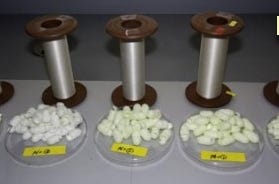World-first textile application for Kraig Biocraft's spider silk; medical and industrial uses on horizon
Five times stronger than steel and three times tougher than Kevlar, by weight, spider silk has galvanized the imaginations of researchers for many years. However, producing or harvesting spider silk protein in a viable way has proven challenging, although a handful of smaller companies are appearing to make a go of it. One of them is Kraig Biocraft Laboratories (Lansing, MI), which announced earlier this month that Warwick Mills (New Ipswich, NH) will use its genetically engineered spider silk to produce textiles for the first time.
June 27, 2014
Five times stronger than steel and three times tougher than Kevlar, by weight, spider silk has galvanized the imaginations of researchers for many years. However, producing or harvesting spider silk protein in a viable way has proven challenging, although a handful of smaller companies are appearing to make a go of it. One of them is Kraig Biocraft Laboratories (Lansing, MI), which announced earlier this month that Warwick Mills (New Ipswich, NH) will use its genetically engineered spider silk to produce textiles for the first time.
 Kraig's Monster Silk is spun by genetically engineered silkworms. When company founder and CEO Kim Thompson first broached university researchers with the idea of producing spider silk from transgenic silkworms, it was greeted with skepticism and worse. He persevered, however, and feels that commercial success is just around the corner. "Much of our lives have been spent in the lab," Thompson told PlasticsToday. "We are leaving the lab now and getting ready to scale up production."
Kraig's Monster Silk is spun by genetically engineered silkworms. When company founder and CEO Kim Thompson first broached university researchers with the idea of producing spider silk from transgenic silkworms, it was greeted with skepticism and worse. He persevered, however, and feels that commercial success is just around the corner. "Much of our lives have been spent in the lab," Thompson told PlasticsToday. "We are leaving the lab now and getting ready to scale up production."
The collaboration with Warwick Mills, a materials engineering company known for TurtleSkin body armor and developing fabrics for the Mars Rover missions, has allowed Kraig to verify that the fibers are compatible with existing yarn processing and textile production methods. "The fact that these advanced materials process well on existing machinery will help speed development of advanced spider silk textiles," says Thompson. The small-scale trials conducted by Warwick Mills also are key in helping to identify areas for development.
"A knitted glove is the first test weave to come out of this collaboration," says Thompson, "and the initial commercial applications of Monster Silk will be in the more mundane textile markets." (Although some forms of spider silk are prohibitively expensive, the means of production used by Kraig—genetically modified silkworms—enable a price point for the material that is similar to traditional silk, according to the company.)
While Thompson is eager to see Monster Silk make its mark on the commodities side of things, higher end applications in the military, industrial, and medical sectors are very much on his radar. "Advanced textiles is a $130 billion market, and we would be very happy with even just a small share of that," says Thompson. The material has almost limitless potential, he adds, from its use in engineering new lightweight polymers for next-generation body armor to orthopedic implants that look like plastic but are protein-based.
"Silk is biocompatible, of course, and the combination of strength with other properties opens up numerous opportunities in medical technology," says Thompson, citing artificial joints, stents, and scaffolds.
"The medical market is the sector that will take the longest to penetrate because of regulatory issues," says Thompson, "but it is very much a focus. As a company, we are looking for market success and profitability, of course, but what better measure of success is there than improving lives?"
Norbert Sparrow is Senior Editor at PlasticsToday. Follow him on twitter @norbertcsparrow and Google+.
About the Author(s)
You May Also Like




